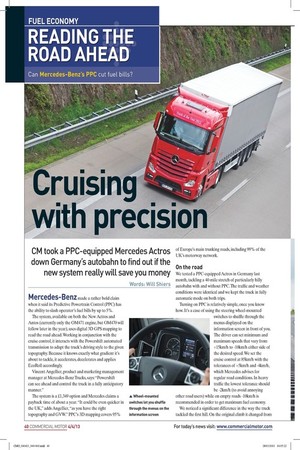Cruising with precision CM took a PPC-equipped Mercedes Actros down
Page 27

Page 28

If you've noticed an error in this article please click here to report it so we can fix it.
Germany's autobahn to find out if the new system really will save you money ,voras: Will Shiers Mercedes-Benz made a rather bold claim when it said its Predictive Powertrain Control (PPC) has the ability to slash operator's fuel bills by up to 5%.
The system, available on both the New Actros and Antos (currently only the 0M471 engine, but 0M470 will follow later in the year), uses digital 3D GPS mapping to read the road ahead. Working in conjunction with the cruise control, it interacts with the Powershift automated transmission to adapt the truck's driving style to the given topography. Because it knows exactly what gradient it's about to tackle, it accelerates, decelerates and applies EcoRoll accordingly.
Vincent Angellier, product and marketing management manager at Mercedes-Benz Trucks, says: "Powershift can see ahead and control the truck in a fully anticipatory manner."
The system is a £1,349 option and Mercedes claims a A Wheel-mounted payback time of about a year. "It could be even quicker in switches let you shuffle the UK," adds Angellier, "as you have the right through the menus on the topography and GVVV." PPC's 3D mapping covers 95% information screen of Europe's main trunking roads, including 99% of the UK's motorway network.
On the road We tested a PPC-equipped Actros in Germany last month, tackling a 40-mile stretch of particularly hilly autobahn with and without PPC. The traffic and weather conditions were identical and we kept the truck in fully automatic mode on both trips.
Turning on PPC is relatively simple, once you know how. It's a case of using the steering wheel-mounted switches to shuffle through the menus displayed on the information screen in front of you. The driver can set minimum and maximum speeds that vary from +15km/h to -10km/h either side of the desired speed. We set the cruise control at 85km/h with the tolerances of +5km/h and -4km/h, which Mercedes advises for regular road conditions. In heavy traffic the lowest tolerance should be -2km/h (to avoid annoying other road users) while on empty roads -10km/h is recommended in order to get maximum fuel economy.
We noticed a significant difference in the way the truck tackled the first hill. On the original climb it changed from 12th to 11th half-way up, then selected 10th about 20 yards from the summit. With PPC turned on it accelerated before the climb, enabling it to hold top gear for longer. When it finally downshifted it held onto 11h for the duration, lugging down to 900rpm. On the steepest hills it block-changed from 12th to 10th, where previously we had made two separate changes, and on a couple of occasions it downshifted ahead of the climb, knowing what it was about to tackle.
Perhaps most impressive is the way PPC eases off the gas before reaching the summit, utilising the vehicle's momentum and allowing kinetic energy to push the truck over the hill. You could argue that the best of drivers would do this automatically, but that's assuming they know the hill.
Although PPC makes plenty of use of Mercedes' EcoRoll (which disengages the driveline for maximum economy), it avoids applying it for anything less than five seconds at a time. Mercedes has calculated that the economy gains achieved by rolling for less than five seconds are outweighed by the fuel used when reengaging the driveline.
When automated manual transmissions first became popular, the general rule of thumb was that they would improve the fuel economy of 75% of drivers, but the top 25% would always get superior results because they were able to see the road ahead. That's now changed, and Mercedes is confident that PPC is every bit as good as your best drivers.
What's more it doesn't get tired, so should be as good as your best drivers all day long. It certainly performed well on this test, improving our fuel economy by close to 10%. • SIMILAR SYSTEMS Although it's not the only such system on the market, according to MercedesBenz, PPC is the "world's first automatic speed control system with integrated transmission intervention". This differentiates it from Scania's Active Prediction Control, which controls the speed but not the gear selection. Angellier describes Scania's system as almost identical to a version offered to Freightliner customers for several years.
Volvo's recently launched I-See is similar to PPC, but needs no 3D mapping, instead using knowledge of the topography learnt via the I-Shift gearbox's gradient sensor and stored from previous trips, correlated to the truck's position on the GPS system. Data from other I-See-equipped trucks is stored on a central server and transmitted automatically to others on the same road.
Last year ZF announced its new Traxon automated transmission, destined to succeed AS-Tronic, which incorporates its GPS-based PreVision. Like PPC it modifies the shift points, but isn't reliant on cruise control. Traxon will go into production later this year, and is likely to be first offered by Iveco and MAN.









































